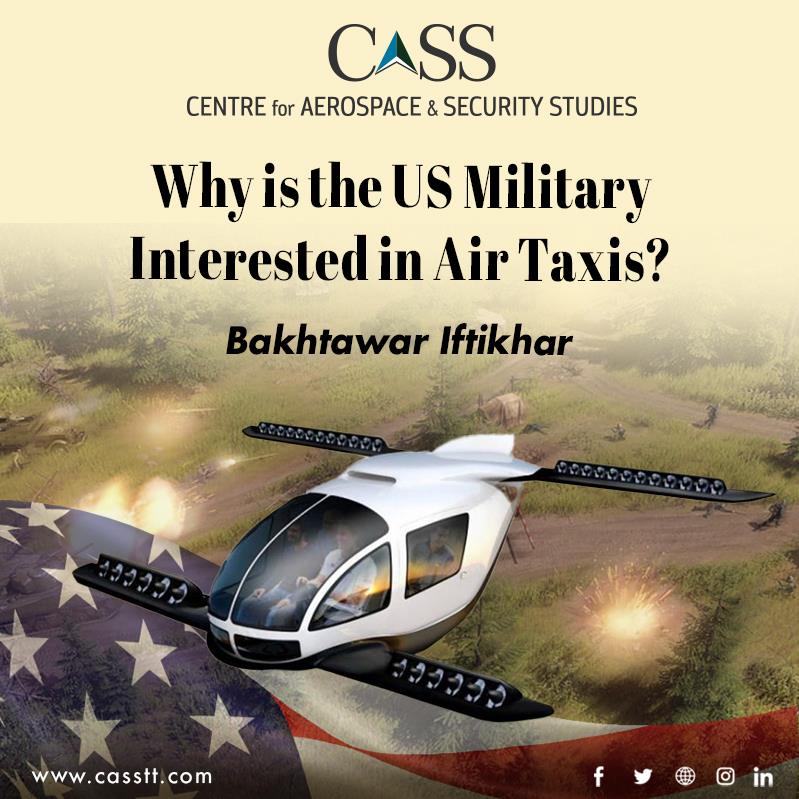Experimenting, inventing and innovating, the human race has taken such monumental strides forward that the sum now seems greater than the parts. The human ability to progress has long been a defining feature of technological advancement. As a result of technological developments, in 1903, the world saw the ‘first successful powered airplane, i.e., the Wright Flyer; in 1919, the first transatlantic flight; by 1957, Boeing 707 finally became the first commercial passenger jetliner; and now, the world may see ‘Electric Vertical Take Off and Landing Vehicles (eVTOLs)’ or ‘air taxis’ by 2025.
Electric VTOLs are similar to helicopters but more advanced, automated and may operate on batteries or hydrogen fuel cells. They fall under the concept of ‘Advanced Air Mobility (AAM)’. According to NASA, AAM seeks to transport people and cargo in ways not served or underserved by current aviation modes. Describing them as a marriage of Tesla and Uber in the sky, the commercial sector has dubbed them ‘flying taxis’.
An intriguing aspect of these air taxis is that they have piqued the interest of the US Department of Defense (DoD). The DoD’s USD 75 million investment in a company called ‘Joby Aviation’ is just one example of this. Others include (but are not limited to) LIFT aircraft, Archer, LiquidPiston and BETA Technologies. The United States Air Force’s Agility Prime programme exclusively focuses on electric VTOLs, having made USD 11 billion in commercial investment ‘to propel the third revolution in aerospace’. This vision of cultivating an innovation ecosystem, through a range of partnerships, underpins the existence of the USAF innovation arm.
The US government’s interest is also driven by the range of benefits that eVTOLs offer specifically in the military domain. Their military utility may be understood given the advantages of vertical flight in general. Unlike traditional aircrafts, eVTOLs eliminate the need for expansive and expensive runways. They provide greater manoeuvrability in mountainous areas, densely populated urban settings, and confined spaces in general, which otherwise are significantly challenging areas for combat. As the world population climbs exponentially and urbanisation increases, military forces must adapt.
eVTOLs may also be preferable to helicopters. They are relatively quieter than their former counterparts and reducing the acoustic signature increases public acceptability as well as increases the element of surprise in the battlefield. The electric half also means lesser mechanical and hydraulic parts in the design, an elegant simplicity that reduces operational and maintenance costs, respectively. Commercialisation would also bring costs down further. The electric battery introduces the DoD to zero emissions aviation, offering hope of escaping the carbon footprints of average helicopters.
Unlike drones that cannot carry people, eVTOLs can be both manned and unmanned or remotely operated. LIFT’s Hexa can accommodate one person; Joby’s and Archer’s, five people each; and BETA’s Alia, six. Moreover, automation based on software simulations improves flight control and hovering ability. LIFT’s Hexa, is one such semi-autonomous eVTOL. It is so light that it was not even classified as an aircraft by the US Federal Aviation Administration standards thus, it requires little training and no pilot’s license.
However, eVTOL technology is not without its challenges. For example, until the battery technology fully matures, hybrid models are in use. Moreover, the trouble with automation is that unexpected automation behaviour is difficult to detect. If a part fails altogether, it is easier to detect, but if a part behaves differently due to an incorrect data entry, the risk multiplies. Even more so if the pilot cannot figure out what exactly is wrong. ‘Mayday!’
Despite such shortcomings, applicability in logistical support, recovery and resupply, and troop insertion and extraction make the technology worth pursuing. US forces can even leverage Hexa’s water-landing capabilities for an amphibious attack. From a technological point of view, collaboration is a fruitful endeavour. The private industry is benefitting from Agility Prime by having access to USAF engineers, and otherwise restricted air space. Such a supportive cushion, particularly from one of the world’s mightiest forces, will help accelerate development. Such public-private partnerships are also likely to catalyse improvement in battery technology as well as potentially reduce technical concerns, such as range, payload, endurance etc. over time, bringing down costs further in the process. Air Force in itself is a child of technological advancement. This approach will help broaden its horizons further.
Innovation begets innovation. Had a toy helicopter made of bamboo not inspired the Wright brothers, perhaps the subsequent breakthroughs in aviation would not have followed, and perhaps there may not have been an electric helicopter under discussion today.
Bakhtawar Iftikhar is a Research Assistant at the Centre for Aerospace & Security Studies (CASS), Islamabad, Pakistan. She can be contacted at: [email protected].





